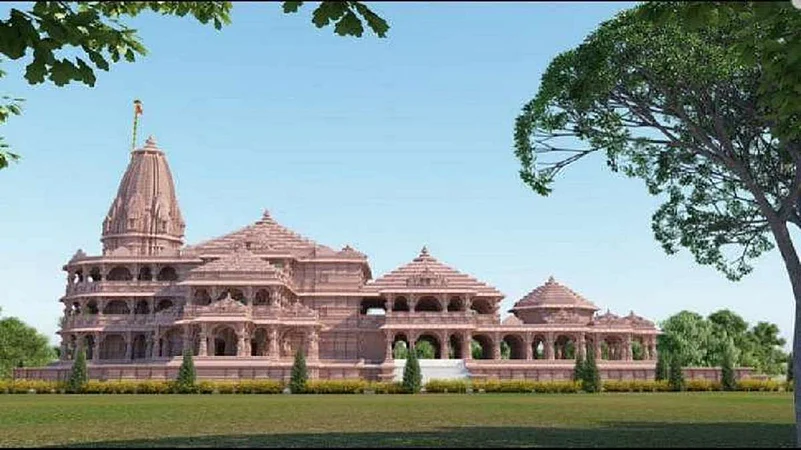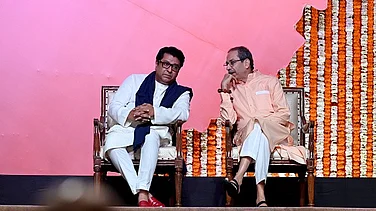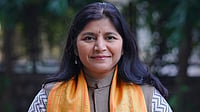Ayodhya, which is believed to be the birthplace of Lord Ram, holds immense spiritual, historical, and cultural significance in the religious and socio-political landscape of India. Since the closing of all the legal battles of the centuries-long land dispute by the Supreme Court in 2022, the construction of the Grand Ram Temple in Ayodhya has been one of the most awaited events in the country.
After years of wait, the consecration or ‘Pran Pratishtha’ ceremony of Ram Lalla idol at the Shri Ram temple is finally taking place on January 22 and preparations are in full swing for the same in Uttar Pradesh’s Ayodhya.

But, how did the intense communal battle over the disputed land involving Hindus and Muslims since the pre-colonial era survive the legal rigmarole to reach this point? Here we present an elaborate timeline of how the dispute unfolded over the centuries and the aftermath of the 2019 judgement by the Supreme Court.
History of Ayodhya dispute
The Ayodhya dispute, more commonly known as the Ram Janmabhoomi-Babri masjid land dispute, represents one of the longest-standing political, historical and socio-religious debates in the landscape of Indian politics.
While hearing a 1991 plea by Muhammad Aslam Bhure and another contempt petition filed in 1992, the Supreme Court in 2022 tied up all the loose ends and closed the centuries-long legal battle regarding the Babri Masjid Demolition in 1992.
Besides upholding the 2019 verdict, the apex court also noted that the contempt plea should have been heard earlier. The Supreme Court also noted that both the destruction of the 16th-century Babri Masjid in 1992 and the placing of an idol inside the mosque in 1949 were against the law.
Babri Masjid construction in 1528
Back in 1528, Babri Masjid was established by Mir Baqi, a commander in the court of emperor Babur. Digging deep into academia, several historical accounts have surfaced that justified the fact that Babur established the mosque upon the ruins of a temple in Ayodhya which is believed to be the capital of Lord Rama’s father Dashrath in the Ramayana.
However, a section of Historians always adhere to the fact that Babur never came to Ayodhya.
The first petitions
The land dispute in Ayodhya dates back to the 1800s when the spot, for the first time, turned into the source of a religious tug-of-war between the Hindus and Muslims. It all started with an alleged dispute in 1855 when Sunni Muslims claimed that the temple in nearby Hanumangarh was built after demolishing a mosque and the claim led to clashes between Muslims and Bairagis.
It is believed that Wajid Ali Shah ruled in favour of the Hindus in the matter.
In 1885, the first plea in the land dispute case was filed in court in Faizabad by Mahant Raghubir Das. However, the plea seeking permission to build a canopy outside the mosque built on the disputed land was rejected by the court.
Hindu-Muslim tug-of-war
In 1934, the communal clashes involving Hindus and Muslims further intensified and resulted in the damage of the mosque’s dome and exteriors. The move that led to further exacerbation of the already disputed situation was the placing of the Ram Lalla idol under the central dome outside the distorted mosque in 1949 by the members of a fringe Hindu outfit called Akhil Hindu Ramayana Mahashabha.
Seeking the right to worship the idol, a petition was filed in 1950 in Faizabad district court while another petition to continue the worship and keeping the idols was filed the same year as well. In 1959, the Hindu religious denomination Nirmohi Akhara filed a suit seeking possession of the site following which, another suit was filed by UP Sunni Central Waqf Board in 1961 contesting the previous one.
After a pause of over two decades, the religious battle gained momentum once again during the latter half of the 80s as a local UP court ordered the then Rajiv Gandhi-led Congress government to open the disputed site for Hindu worshippers in 1986. The move led to religious tensions in UP and other places in the country.
In August 1989, the Allahabad HC ordered a status quo concerning the disputed structure.
Babri demolition
On December 6, 1992, the Babri Masjid was demolished by ‘kar sevaks' during the culmination of veteran BJP leader and former Deputy Prime Minister Lal Krishna Advani’s Rath Yatra from Gujarat’s Somnath to UP’s Ayodhya.Advani was one prime accused in the case related to the mosque's demolition along with fellow BJP veterans Murli Manohar Joshi, Kalyan Singh, Uma Bharti, and others.
Three-way division: The 2010 judgement
In 2010, the Allahabad High Court ruled in favour of a three-way division of the disputed area between the Ram Lalla petitioners, the Sunni Waqf Board and, the Nirmohi Akhara.
Ram Lalla’s victory
In 2019, the apex court set up a five-judge constitution bench to hear the title case. The same year, the Centre also moved SC for permission to return the 67-acre acquired land around the disputed site to its original owners. The Supreme Court ruled that the case should be mediated by a panel headed by former SC judge FMI Kallifulla.
On November 9, SC granted all of the 2.77 acres of disputed land in Ayodhya to the deity Ram Lalla and ruled that the possession of land would remain with the central government receiver.
However, the apex court also directed the Centre and UP government to allot 5-acre land to the Muslims at a prominent place for building a mosque.
In 2020, a 15-member Trust for Ram Temple in Ayodhya was announced in Parliament.
All 32 accused in the Babri demolition case, were acquitted in September 2020 by a special CBI court including LK Advani, Murli Manohar Joshi, Uma Bharti and, Kalyan Singh.
In 2022, the SC closed all cases regarding the Babri demolition.
Ram Mandir temple complex: The ‘Atmanirbhar’ architecture
The map of the revamped Ram Mandir Temple Complex in Uttar Pradesh’s Ayodhya has been released ahead of its grand opening scheduled on January 22 by the Ram Temple Trust where they have shared a holistic view of the sprawling 70-acre temple premises. According to the temple trust, the planning and architecture of the newly built complex represent the 'Aatmanribhar' narrative.
As per the map, the devotees will enter the temple from the east side, while they will exit from the southern side. Precisely, the devotees will have to tread 32 steps from the eastern side to reach the main temple. The complex will also have a lift and two ramps at the entrance for the elderly and people with disabilities.
From sewer plants, and water treatment plants to a fire brigade post and a dedicated power line, the temple complex encompasses a long list of state-of-the-art facilities.
There will also be a pilgrim facilitation complex with a healthcare centre and a toilet block in the temple complex. Moreover, it has been said that 70 per cent of the 70 acres of the temple complex will be covered by greenery including centuries-old trees.
The temple architecture
Being 250 feet wide and 161 feet high edifice of the traditional Nagara style, a sub-category of Hindu Temple Architecture, the temple is a three-storey superstructure where each temple floor is 20 feet high and has a total of 392 pillars and 44 gates.
Moreover, the temple will have a 14-foot wide percota spanning 732 metres, which otherwise is rarely found in north India. The four corners of the 'percota' will be dedicated to the Sun God, Maa Bhagwati, Lord Ganesha and Lord Shiva respectively. On the northern side, there will be a shrine for Maa Annapurna and on the southern side, there will be one for Lord Hanuman.
'Best' one chosen from three idols of Ram Lalla
Initially, three idols of Ram Lalla were in the fray for the grandiose consecration ceremony out of which the 'best' sculpture that 'brought to life the tenderness of a five-year-old child' sculpted by Mysuru-based Arun Yogiraj has been chosen and will be placed in the sanctum sanctorum of the newly built temple on January 22.

The three idols were reportedly made by three sculptors - Ganesh Bhatt, Arun Yogiraj and Satyanarayan Pandey. As per the Temple trust's general secretary Champat Rai, the chosen idol depicts the deity as a five-year-old boy in standing posture and added that it would be placed at its 'Aasan' in 'Garbh Griha' (sanctum sanctorum) on January 18.
Yogiraj also sculpted the idol of Adi Shankaracharya, which has been placed in Kedarnath, and the statue of Subhas Chandra Bose which has been installed near India Gate in Delhi.
Grand Inauguration/Consecration Ceremony
With preparations running in full swing, the temple trust had chalked out a seven-day agenda of rituals and events ahead of the consecration ceremony. The extensive seven-day plan encompassed Pran Pratishtha started on January 17 while the formal consecration ceremony will take place on January 22 with the advent of the idols in a grand procession called ‘Nishan Yatra’
The other significant rituals include Agni Sthapana, Navagraha Sthapana, and Havan followed by the cleaning of the sanctum sanctorum with holy water from the Saryu River in a ritual referred to as ‘Abhishek’. Then, the idol of Ram Lalla and Sita Mata received a divine tub with 125 urns of holy water in a rite known as ‘Shayadhivas.’
The seven-day-long journey of religious rituals is scheduled to culminate on 22 January with the idols being placed in the sanctum sanctorum throughout the auspicious 'Mrigashira Nakshatra'.
Who all are invited to Ram Mandir Consecration
On January 22, the Ram Mandir will be inaugurated in the presence of Prime Minister Narendra Modi. Besides, saints, priests, Shankaracharyas, religious leaders, former civil servants, retired Army officers, and lawyers, the temple trust has also invited journalists and administrative officers who were posted in the Ayodhya region around 1992. Around 100 representatives from different countries are also expected to be present during the grand ceremony.
With over 7,000 invitees for the idol consecration ceremony of Ram temple in Ayodhya on January 22, the detailed guest list includes the names of spiritual and religious leaders like Dalai Lama, Mata Amritanandamayi of Kerala and Baba Ramdev alongside film stars like Amitabh Bachchan and Rajnikanth Madhuri Dixit, Arun Govil, and film director Madhur Bhandarkar.
Eminent sports personalities including Virat Kohli, MS Dhoni, Ravichandran Ashwin, PT Usha, Mary Kom, Sania Mirza, Kapil Dev and, Sunil Gavaskar are amongst several others who have received official invitations from the temple trust.
The list also includes prominent industrialists such as Mukesh Ambani, Anil Ambani, Ratan Tata, famous painter Vasudev Kamat, and Nilesh Desai, Director, Space Applications Centre (SAC/ISRO), Ahmedabad.
Ayodhya’s facelift ahead of Ram Mandir inauguration
Right ahead of the inauguration ceremony, Ayodhya received a massive facelift with the unveiling of the Maharshi Valmiki airport and the redeveloped railway junction by Prime Minister Narendra Modi on December 30, 2023. The prime minister also flagged off two Amrit Bharat Express and six Vande Bharat Express trains on the same day.
Moreover, PM Modi also launched a range of developmental projects worth more than Rs 11,100 crore to revamp civic facilities and develop world-class infrastructure in Ayodhya and projects worth over Rs 4,600 crore for other parts of Uttar Pradesh.
To enhance accessibility to the upcoming Ram temple, he also inaugurated four newly redeveloped, widened and beautified roads in Ayodhya - Ram Path, Bhakti Path, Dharm Path, and Shri Ram Janmabhoomi Path.



























